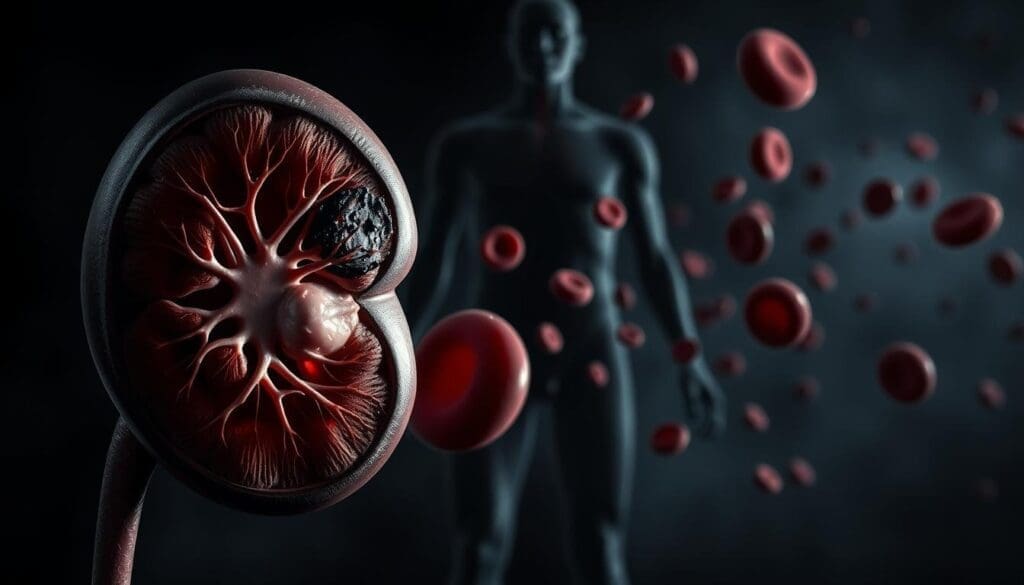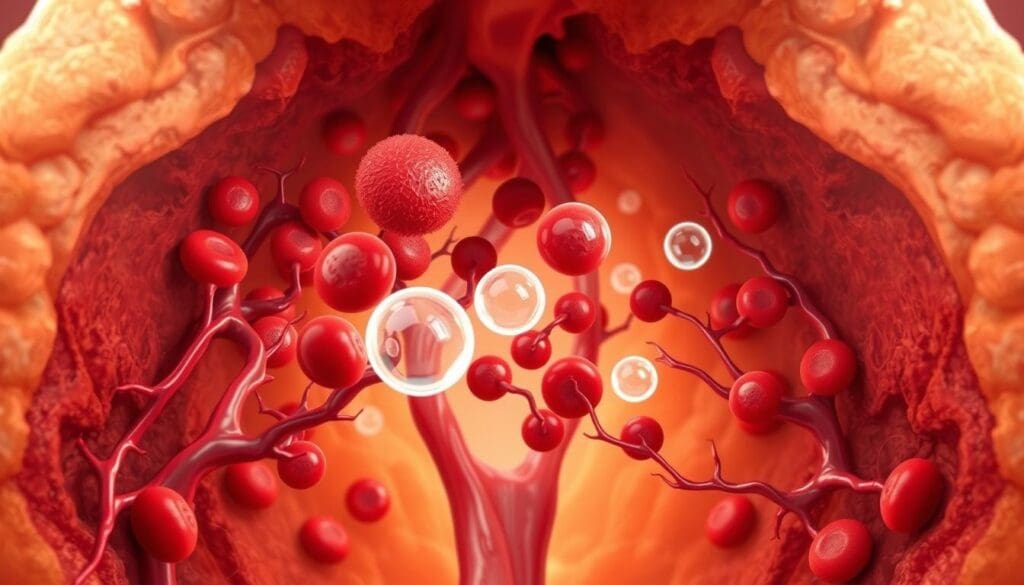Last Updated on November 14, 2025 by Ugurkan Demir

Anemia is a common problem for people with chronic kidney disease (CKD). It makes their quality worse and raises the risk of heart issues. This condition happens when there are fewer red blood cells, causing fatigue, weakness, and shortness of breath.
Liv Hospital has new hope for those dealing with this complex issue. Thanks to advances in care, we now know more about anemia due to chronic renal failure. We also have better ways to treat it.

Anemia linked to chronic kidney disease (CKD) is a serious issue that needs careful handling. It happens when there are fewer red blood cells or less hemoglobin in the blood. This makes it hard for tissues and organs to get enough oxygen.
Anemia in CKD patients can lead to fatigue, weakness, and shortness of breath. These symptoms greatly affect their daily life. The signs of anemia can differ from person to person b,,u but often include:
Anemia becomes more common as CKD worsens, mainly in stages 4 and 5. Research shows that anemia can greatly affect patient outcomes. It can increase the risk of heart disease, hospital stays, and death.
| CKD Stage | Prevalence of Anemia | Impact on Patient Outcomes |
| Stage 3 | Moderate | Increased risk of cardiovascular disease |
| Stage 4 | High | Higher risk of hospitalization |
| Stage 5 | Very High | Significant risk of mortality |
It’s key to understand the impact of anemia in CKD. This knowledge helps in creating better ways to manage it and improve patient results.

Anemia in chronic kidney disease is linked to problems with making red blood cells. This is because the kidneys, which help make a hormone called erythropoietin, don’t work right. Knowing how this affects patients is key to treating their anemia.
Erythropoiesis is how red blood cells are made. It involves many cell types, growth factors, and hormones working together. Erythropoietin (EPO) is very important in this process. It helps make more red blood cells when there’s not enough oxygen in the blood.
In chronic kidney disease, the kidneys can’t make enough EPO. This means fewer red blood cells are made. This is a big reason why anemia happens. Also, CKD makes the body more inflamed, which affects the iron levels needed for red blood cells.
Red blood cells also don’t last as long in CKD patients. This is because of toxins and stress in the body. Treating anemia in CKD needs to tackle all these issues, not just EPO levels.
Diagnosing renal anemia requires a detailed approach. This includes lab tests and ruling out other causes. According to
“Guidelines for the diagnosis and treatment of anemia in chronic kidney disease,” accurate diagnosis is key for good management.
Laboratory tests are vital in diagnosing renal anemia. The first step is a complete blood count (CBC). This checks hemoglobin levels, hematocrit, and red blood cell indices.
Key parameters include:
These tests show how severe the anemia is and what might be causing it. For example, a low MCV means microcytic anemia, while a high MCV means macrocytic anemia.
Differential diagnosis helps tell renal anemia apart from other anemia types. It looks at the patient’s iron status. This includes serum iron, total iron-binding capacity (TIBC), and ferritin levels.
Other things to check include:
By using lab tests and differential diagnosis, doctors can accurately diagnose renal anemia. They can then create a treatment plan.
The kidneys are key in making erythropoietin, a hormone needed for red blood cells. This hormone tells the bone marrow to make more red blood cells. These cells carry oxygen around the body. But inn chronic renal failure, the kidneys can’t make enough erythropoietin, causing anemia.
The kidneys make about 90% of our erythropoietin. Erythropoietin production is tightly regulated by oxygen levels in the body. When oxygen levels drop, the kidneys make more erythropoietin to boost red blood cell production. In chronic kidney disease (CKD), the kidneys can’t make enough, leading to anemia.
Kidney function and erythropoietin production are closely linked. As kidney function goes down, so does erythropoietin production. Research shows that those with advanced CKD have much lower erythropoietin levels than those with mild CKD or healthy people. This shows how important kidney function is for making enough erythropoietin.
“The kidney’s role in erythropoietin production is a critical aspect of its endocrine function, and its impairment in CKD is a major contributor to the development of anemia.”
The drop in erythropoietin production in CKD patients is complex. It’s influenced by how bad the kidney disease is and other factors like inflammation and oxidative stress. Knowing why this happens is key to finding better treatments.
Anemia in CKD patients often comes from iron deficiency. This can be either absolute or functional. It’s key to understand these types for better anemia management.
Absolute iron deficiency means the body has less iron. This can happen from not eating enough iron, losing blood, or using more iron than needed. On the other hand, functional iron deficiency means the body has enough iron but can’t use it for making blood cells. This is often because of inflammation or using certain blood-making drugs.
Key differences between absolute and functional iron deficiency include:
CKD changes how the body handles iron. It leads to more hepcidin, which makes it harder for the body to absorb iron. This results in a functional iron deficiency, even with enough iron stored.
The complex relationship between iron metabolism and CKD is shown by:
To manage iron deficiency in CKD patients well, we need a detailed plan. This includes correct diagnosis, the right iron supplements, and fixing the reasons for iron loss or poor use.
Blood loss is a big worry for people with chronic kidney disease (CKD), even more so for those on dialysis. Anemia risk goes up because of blood loss. This can happen for many reasons.
Hemodialysis is a common treatment for end-stage renal disease. It can lead to blood loss. This happens for a few reasons:
Reducing blood loss during hemodialysis is key tfighting anemiaia. Ways to do this include taking fewer blood samples. Also, using methods to cut down on leftover blood in the dialyzer.
Uremic patients face a higher risk of gastrointestinal bleeding. This is because of uremia-induced platelet dysfunction and mucosal damage. It can cause a lot of blood loss and make anemia worse.
Managing gastrointestinal bleeding in CKD patients involves several steps:
Dealing with blood loss, whether from dialysis or gastrointestinal bleeding, is vital for managing anemia in CKD patients. Understanding the causes and using the right strategies can help healthcare providers improve patient outcomes.
Chronic inflammation is a big problem in chronic kidney disease (CKD). It plays a big role in causing anemia. CKD patients often have high levels of inflammatory cytokines.
This inflammation messes with how our body makes red blood cells. This leads to anemia.
Inflammatory cytokines are key in making anemia worse in CKD. Cytokines like TNF-alpha, IL-1, and IL-6 stop the body from making enough erythropoietin (EPO). EPO is important for making red blood cells.
These cytokines also make hepcidin, a protein that controls iron. Too much hepcidin means less iron for making red blood cells. This makes anemia even worse.
Oxidative stress also plays a part in anemia in CKD patients. It causes damage to red blood cells, making them die early. This makes it harder for the body to make enough red blood cells.
Oxidative stress also hurts the production of EPO. This makes it even harder for the body to make red blood cells. This makes anemia worse.
Chronic inflammation and oxidative stress together make it hard for CKD patients to make red blood cells. It’s important to understand this to find better treatments.
| Mechanism | Effect on Erythropoiesis | Impact on Anemia |
| Inflammatory Cytokines | Suppress EPO production and erythroid progenitor cell responsiveness | Increased severity of anemia |
| Oxidative Stress | Damages red blood cells and impairs EPO production | Premature destruction of red blood cells, worsening anemia |
By fighting chronic inflammation and oxidative stress, doctors can make better plans to treat anemia in CKD patients.
In people with CKD, red blood cells don’t last as long. This leads to anemia.
Normally, red blood cells live about 120 days. But in CKD, they don’t last as long. This is due to several reasons.
There are a few reasons why red blood cells in CKD patients don’t last long. These include:
These reasons are complex. They involve changes to the red blood cells and the uremic environment.
Uremic toxins play a big role in the early destruction of red blood cells. These toxins build up in the blood of CKD patients because their kidneys can’t clear them out.
Some important uremic toxins include:
These toxins cause oxidative stress and inflammation. This makes red blood cells die off faster.
It’s important to understand why red blood cells don’t last long in CKD. This knowledge helps in finding better ways to treat anemia in these patients.
Anemia in CKD patients often gets worse because of a lack of important nutrients. This includes vitamin B12 and folate. These vitamins are key to making red blood cells.
Vitamin B12 and folate shortages are common in CKD patients. This is because of diet limits and how CKD affects the body. A study showed that up to 30% of CKD patients might not have enough vitamin B12, leading to anemia.
These shortages happen for a few reasons:
CKD patients often eat less because of diet rules. For example, avoiding foods high in potassium means they might not get enough folate from fruits and veggies.
The table below shows how diet rules in CKD can affect vitamin B12 and folate levels:
| Dietary Restriction | Nutrient Impact |
| Low potassium diet | Less folate from fruits and veggies |
| Avoidance of animal products | Higher risk of vitamin B12 shortage |
| Limited intake of fortified cereals | Less folate |
Handling anemia in CKD needs a full plan. This includes fixing nutritional gaps. Doctors should watch for vitamin B12 and folate shortages and include them in treatment plans.
Hepcidin and FGF23 are key players in the anemia of CKD. They affect iron use and red blood cell production. New studies have shed light on how they contribute to anemia in chronic kidney disease.
Hepcidin controls iron levels in the body. In CKD patients, high hepcidin levels trap iron, making it hard for red blood cells to form. This creates a problem even when there’s enough iron.
Mechanism of Action: Hepcidin stops cells from releasing iron. It does this by binding to ferroportin and causing it to break down. This lowers the iron in the blood.
“Hepcidin is a key regulator of iron metabolism, and its dysregulation contributes to the anemia of CKD by limiting iron availability for erythropoiesis.”
— Source: Journal of the American Society of Nephrology
| Condition | Hepcidin Level | Effect on Iron |
| CKD | Elevated | Iron Sequestration |
| Normal | Normal | Normal Iron Metabolism |
FGF23 is a hormone made by bones. It’s linked to CKD problems, including anemia. New research shows FGF23 also affects red blood cell production.
Impact on Erythropoiesis: FGF23 stops the body from making erythropoietin. This hormone is vital for making red blood cells. Without it, anemia gets worse in CKD patients.
Learning about hepcidin and FGF23 in CKD anemia offers new ways to treat it. Targeting these factors might help manage anemia better in CKD patients.
Managing anemia in patients with chronic kidney disease needs a detailed plan. This plan should tackle the root causes of anemia. It also uses different treatments to help patients get better.
Iron supplements are key in treating anemia in CKD. Intravenous iron works better than oral iron. It helps replace iron and supports the making of red blood cells.
The right intravenous iron depends on the patient’s needs, how well they tolerate it, and the cost. It also depends on the specific situation of the patient.
| Iron Formulation | Dosing Schedule | Advantages |
| Iron Sucrose | 100-200 mg IV, 2-3 times a week | Well-tolerated, effective |
| Ferric Carboxymaltose | Single dose or split doses up to 1000 mg | Reduces the need for frequent dosing |
| Ferric Derisomaltose | Single dose up to 1000 mg | Simplifies treatment regimen |
ESAs help make more red blood cells in patients with CKD. Darbepoetin alfa and epoetin alfa are two ESAs that work well. They help increase hemoglobin levels and cut down on blood transfusions.
The dose and how often to give ESAs change based on the patient’s response and iron levels.
New treatments for anemia in CKD are being developed. HIF stabilizers are a new type of oral medicine. They help make more red blood cells and improve iron use.
Dealing with anemia in CKD is complex. It needs a plan that fits each patient’s needs. By using iron supplements, ESAs, and new medicines, doctors can help patients feel better and live better lives.
Managing anemia in chronic kidney disease (CKD) needs individualized treatment plans. These plans must consider the many factors that cause anemia. Anemia in CKD comes from several sources, like less erythropoietin, iron deficiency, and chronic inflammation.
Healthcare providers can create specific plans for anemia management by knowing the causes. The Kidney Disease: Improving Global Outcomes (KDIGO) guidelines suggest using erythropoiesis-stimulating agents (ESAs) and iron supplements for CKD patients.
Customizing CKD care for each patient can lead to better results and a better life. With individualized treatment, healthcare providers can better manage anemia and slow the disease’s progress.
Anemia in chronic renal failure, also known as anemia of chronic kidney disease (CKD), is a condition. It happens when there are fewer red blood cells or less hemoglobin. This is often because the kidneys can’t make enough erythropoietin, a hormone that helps make red blood cells.
Symptoms of anemia in CKD include feeling very tired, weak, and short of breath. You might also notice your skin looks pale. These symptoms can really affect your quality.
Doctors use lab tests to diagnose anemia in CKD. They check your complete blood count (CBC) to see your hemoglobin and hematocrit levels. They also do other tests to find out why you might have anemia.
Erythropoietin is a hormone made by the kidneys. It’s key to making red blood cells. In CKD, not enough erythropoietin is made, leading to anemia.
Iron deficiency is a big problem in CKD anemia. It can come from not getting enough iron, losing too much, or problems with iron use in the body. All these can lead to fewer red blood cells.
Chronic inflammation in CKD can cause anemia. It affects how red blood cells are made and raises hepcidin levels. Hepcidin makes iron hard to use for making red blood cells.
Treating anemia in CKD includes iron supplements and erythropoiesis-stimulating agents (ESAs). Doctors also try to fix underlying issues like inflammation or nutritional problems. New treatments that target the hypoxia-inducible pathway are being looked into t ,oo.
Hepcidin is important for iron use in the body. It helps control iron absorption and storage. High hepcidin levels in CKD can cause iron deficiency, leading to anemia.
Yes, not getting enough vitamins like B12 and folate can cause anemia in CKD. Diet restrictions and losing nutrients during dialysis can make these deficiencies worse.
Blood loss, like from dialysis or bleeding in the gut, can lead to anemia in CKD. It reduces the number of red blood cells in your body.
FGF23 is a hormone involved in phosphate use. It has been found to affect how red blood cells are made. This could play a part in anemia in CKD.
Subscribe to our e-newsletter to stay informed about the latest innovations in the world of health and exclusive offers!